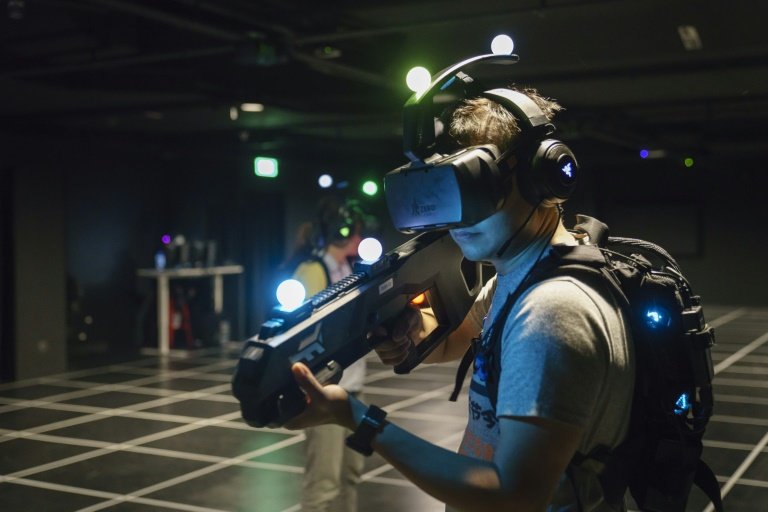
The world of games used to be limited to screens and controllers, providing players with a way to escape visually and audibly into fantastical realms. But as technology keeps getting better, a new realm has opened up that lets gamers go beyond the limits of normal interfaces. Welcome to the exciting world of Virtual Reality (VR) games, where pixels go beyond screens and hand movements replace controllers to create a level of immersion that has never been seen before.
Virtual reality gaming isn’t just an improvement in technology; it’s a revolution that has changed what interactive enjoyment is all about. When you put on a headset, you’re no longer just directing a character; you are the character, exploring beautiful landscapes, fighting strange creatures, and feeling the heart-pounding thrill of a virtual world that so closely resembles real life.
The Evolution of Virtual Reality Gaming:

To truly understand the significance of VR gaming, one must trace its evolution. The concept of virtual reality has been around for decades, with early attempts dating back to the 1960s. However, it wasn’t until recent years that technology caught up with the ambitious dreams of creating a truly immersive gaming experience.
Today’s VR headsets, such as the Oculus Rift, HTC Vive, and PlayStation VR, transport players into meticulously crafted digital environments, providing an unparalleled sense of presence. Technology advancements in display, tracking, and motion controllers have all contributed to the evolution of VR gaming by bridging the gap between reality and the digital world.
Breaking Down Barriers:
One of the most enticing aspects of VR gaming is its ability to dissolve the barriers between the player and the game. No longer confined to a flat screen, gamers can turn their heads and glance in any direction, exploring the virtual world as if it were their own. The sense of scale, depth, and spatial awareness in VR is so convincing that it blurs the lines between what’s real and what’s not.
Beyond visual immersion, VR gaming engages the entire body. Motion controllers, haptic feedback, and room-scale tracking allow players to physically interact with the virtual environment, making every gesture, swing, or dodge an integral part of the gaming experience. This level of engagement transcends traditional gaming, creating an emotional and sensory connection that is unprecedented in the history of interactive entertainment.
Diverse Realms Await:

Virtual Reality gaming offers a diverse array of experiences, catering to a wide spectrum of tastes and preferences. From heart-pounding action adventures to serene exploration games, and from intense sports simulations to mind-bending puzzles, the VR landscape is as varied as the imagination itself. Developers are pushing boundaries, crafting experiences that challenge perceptions and redefine the possibilities of gaming.
Unleashing Creative Potential:
The canvas of VR gaming isn’t just limited to replicating the real world; it extends into the fantastical realms of creativity. Developers are harnessing the power of virtual reality to create experiences that defy the laws of physics and unleash the imagination. From painting in 3D space to sculpting virtual masterpieces, VR is fostering a new era of interactive artistry. Virtual Reality not only invites players into pre-designed worlds but also empowers them to craft their own, pushing the boundaries of what is possible in the realm of gaming.
Social Connection in a Virtual Space:
Gaming has always been a social activity, but VR takes this camaraderie to new heights. Multiplayer VR experiences allow friends, no matter the physical distance, to share the same virtual space. Whether collaborating on a mission, engaging in friendly competition, or simply hanging out in a digital environment, VR has transformed gaming into a truly social affair. Virtual reality doesn’t just connect people through screens; it transports them into shared adventures, forging bonds that extend beyond the confines of the digital world.
Challenges and Opportunities:
While the world of VR gaming is filled with promise, it’s not without its challenges. The cost of high-end VR equipment, the need for powerful computing systems, and concerns about motion sickness are some hurdles that the industry continues to address. However, as technology progresses and becomes more accessible, these challenges are gradually transforming into opportunities, making VR gaming more inclusive and engaging for a broader audience.
Future Frontiers:

As we traverse the current landscape of VR gaming, it’s essential to look ahead to the future frontiers awaiting exploration. Augmented Reality (AR) is on the horizon, promising to merge the virtual and real worlds seamlessly. With advancements in haptic technology, AI-driven interactions, and the potential integration of brain-computer interfaces, the possibilities for the future of VR gaming are boundless.
Conclusion:
Virtual reality games are a huge step forward in interactive fun because they break down barriers between players and digital experiences. It provides a variety of imaginative worlds, social connections, and the freedom to be artistic. As augmented reality and other new technologies keep coming out, they change how we think about and connect with interactive entertainment.


